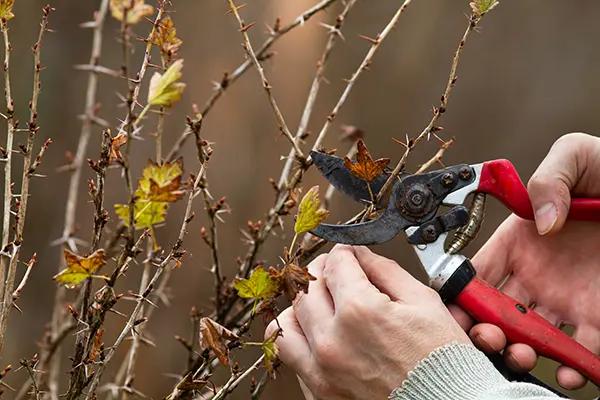Gooseberry bushes are pruned almost exactly the same way as Red & Whitecurrant bushes.
Pruning is so important for getting good crops of well-developed fruit.
Table of Contents
The difference between pruning a Gooseberry Bush, and Red or Whitecurrants
Gooseberry bushes are pruned the same as Red or Whitecurrants, with one detail different.
- Currants are naturally more upright, so each pruning cut is made above an outward facing bud, which is normal for pruning most shrubs.
- Gooseberries naturally have more droopy branches, so where an outward facing bud points down too much, pruning cuts are made above an inward/upward facing bud instead.
Pruning as An Open Centred Bush
A “goblet shaped” bush is an ideal form for growing crops that ripen well on tidy plants with air flow around the base, which makes a big difference to preventing mildew.
Formative pruning, done in the first couple of years, establishes the form of the bush, with a single leg or trunk 10-15cm tall, branching into an open centred, bowl shape.
With a mature bush, you just keep the centre free of ingrowing branches and trim back the new season’s side shoots to help divert energy to the berries that appear at their bases.
Where to make the cuts: You want to counteract drooping stems, which is more of an issue with gooseberries:
- Horizontal stems: Prune back to an inward/upward facing bud or an upright side-shoot.
- Upright stems: Prune normally to an outward facing bud if the branch.

Bush Pruning Year by Year
- Pruning after Planting: Trim all the branches by one half of their length, as described above.
- Year Two: The following winter, around November, shorten all the main stems that you trimmed last year by one half of their new growth.
- Inspect the new side shoots that appeared this year: use your judgement to choose the best placed ones (outward and upward facing, not congested with other branches) and shorten these stems by half as well. Remove the others.
- Remove any suckers or shoots low down on the trunk, and do this every year from now on; some varieties will do it more than others.
- Year Three: Your bush should have its core framework of main branches from last year, each with two or three new leading stems from the summer, and be ready to begin serious cropping: well done!
- During the winter, prune the leading stems back by a half of their new growth.
- Remove shoots that point into the centre and identify leaders that are crossing or pointing downwards: shorten these down to about 2 – 3 inches.
Happily ever after! Your bushes now need a twice yearly trim to keep them in shape.
- Summer: In the first week of July (not earlier), trim all new side-shoots down to 5 leaves. There’s no need to prune the tips of the leading stems unless they have mildew.
- Winter: During the winter, cut back the leading stems by half of their new growth. Now shorten all the lateral side-shoots that you took down to 5 leaves in the summer: this time, cut them back to two buds. If you cut them back to three buds, you will get more, smaller fruit.
Pruning as Cordons or Fans on Wires
Handy for tight corners and limited spaces, cordons can be single, double or triple stemmed, at which point they are more like a fan.
Support on a wall or wire frame will be required: a good long bamboo cane is enough for single stem cordons.
- Training single stemmed cordons. After planting, cut the main vertical stem back by half of the previous season’s new growth, cutting back all other shoots back down to 1 bud.
- Remove all buds on the bottom 4 inches of the trunk.
- Early July pruning: In the beginning of July, the summer after planting, reduce the new growth on the side shoots by pinching back to three or four leaves: repeat this bit at the same time every summer thereafter.
- As for the leading stem, tie it to the cane or a wire, but don’t summer prune it this year. Just winter prune and let it reach 5-6 feet in length before you trim it each summer too, leaving four leaves on it.
- Winter Pruning: Cut all the laterals that you shortened in summer to little 1 inch stubs, just ahead of the first bud. Prune the main stem, leaving 6 inches of new growth. When it is fully grown, just leave one bud of new growth each year.
